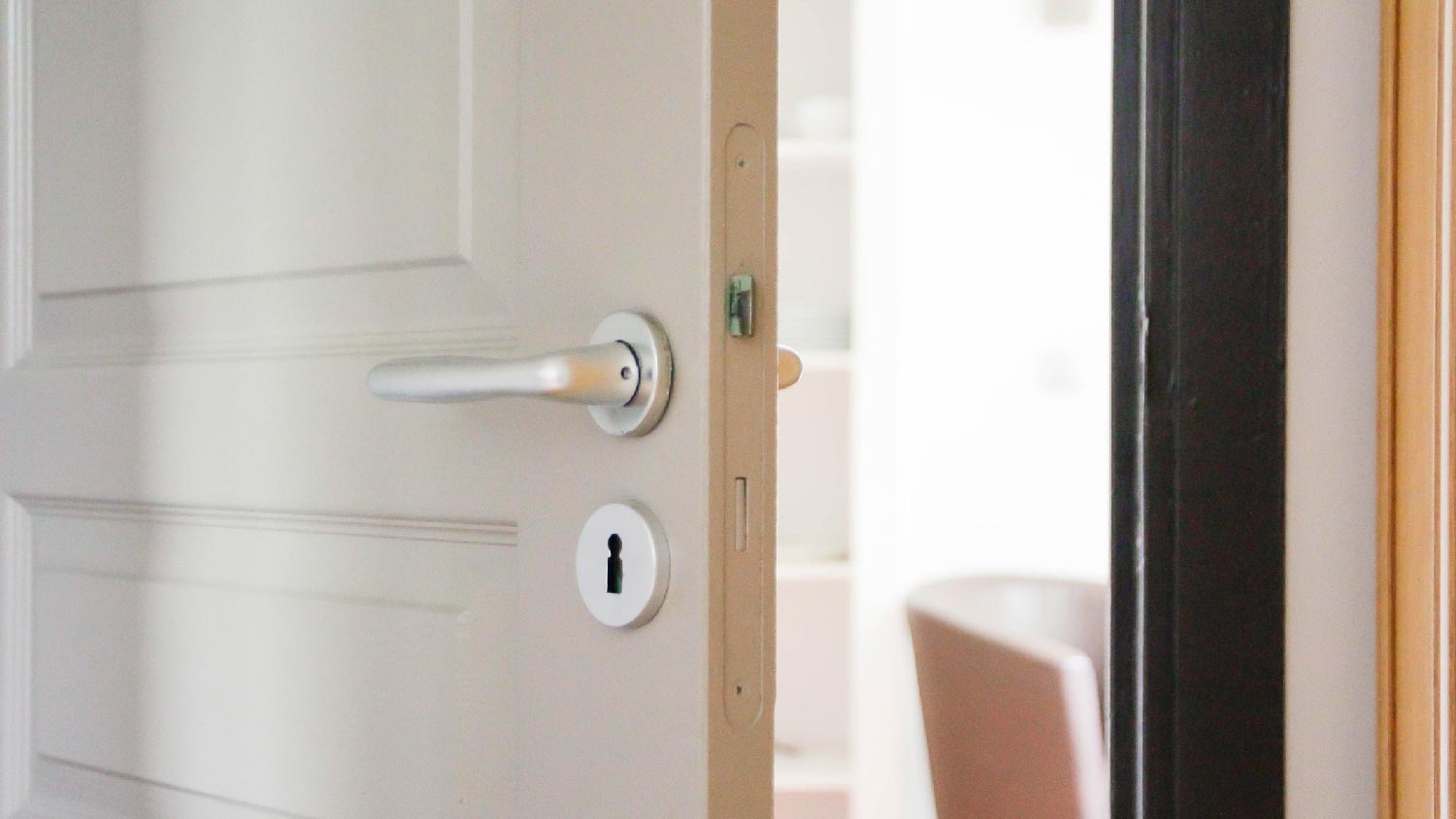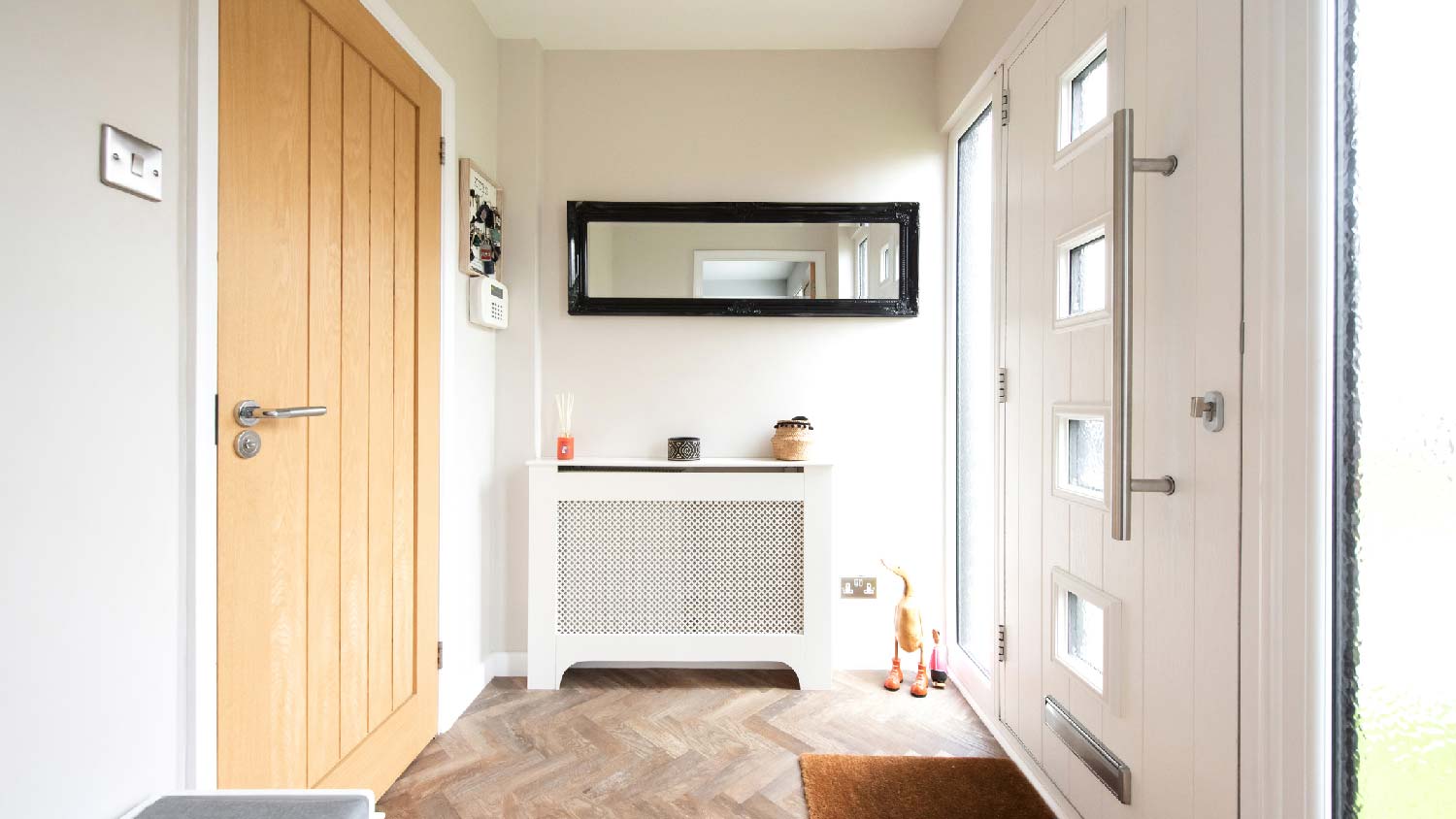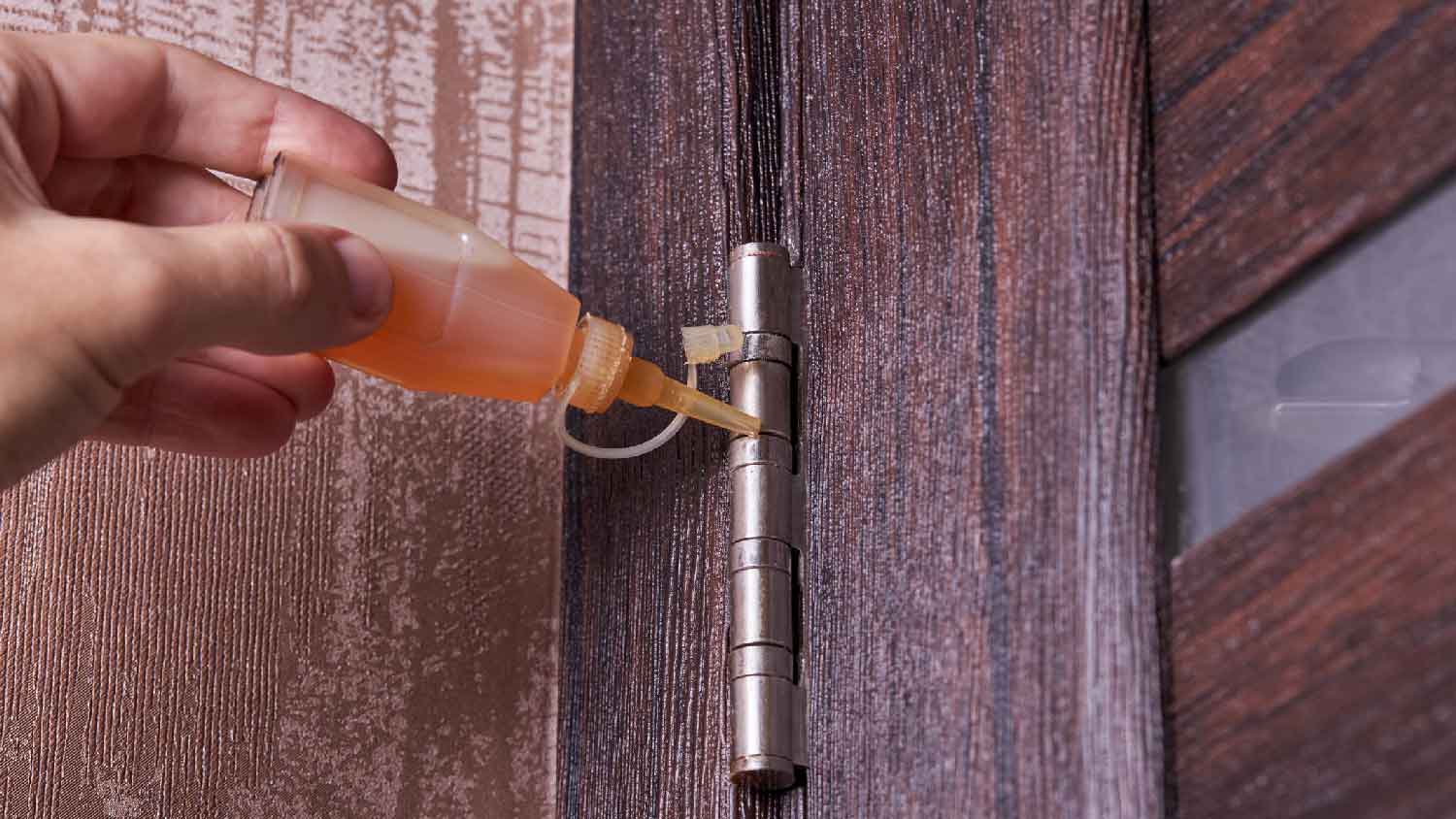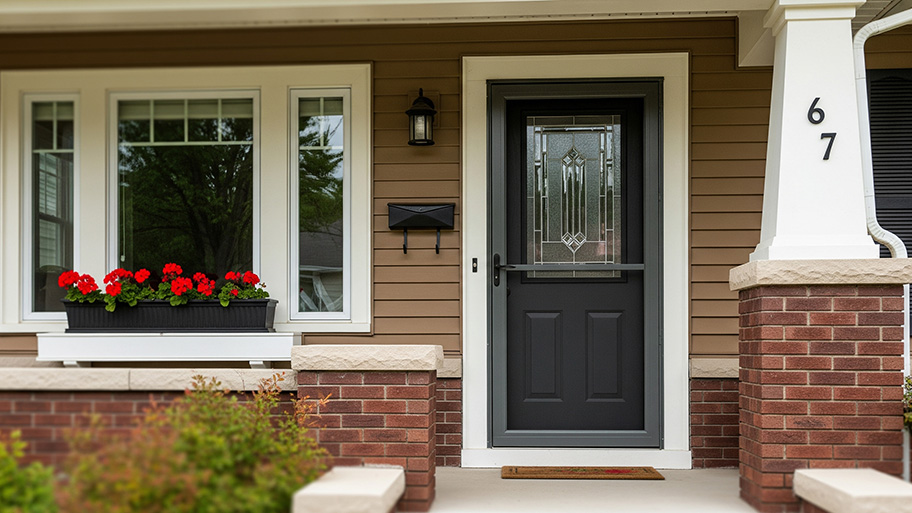
Create more usable space by installing a garage door screen, which allows for entertaining or working with plenty of fresh air and zero bugs. Here’s how much installing a garage door screen will cost you.
Knock it off—here’s how to get rid of annoying door problems


Door installation problems can be minor, like squeaky hinges or a rattling door.
Some can be more detrimental, like a drafty door or a door that won’t close.
It’s possible to try to fix some door-hanging problems on your own.
Call a professional door installer if you’re unable to fix the issue yourself.
Hanging a door on your own can save some money on door installers, but it can also be tough work if you’ve never done it before. It’s definitely worth learning how to hang a door if you like a challenge, but you should make sure you know how to recognize door installation problems you might encounter and how to fix them. It’s also possible to experience door problems long after a door was installed, even professionally, and you’ll want to know how to address those issues, too.
Below, we’ll cover several door hanging problems you might encounter. Plus, we’ll walk you through common fixes and identify when it might be better to call in a pro.
When you’ve finished installing your door, check to make sure it’s perfectly aligned. If you notice the door is uneven at the top or the wall plates are misaligned on the bottom, you’ll need to fix your work.
If the door won’t shut because it’s not flush at the top, it’s possible that the door wasn’t installed on a level surface or that the door hinges aren’t plumb. If the floor is uneven, you’ll need to sand down one side of the door so that it can close properly. Alternatively, use a level to check to see if the door is out of plumb—in this case, you need to adjust the bottom wall plates.
If you can’t get your door to close and aren’t sure how to fix the issue, it’s easier (and safer) to call a professional door installer near you to address the issue. If you’re going to try to tackle any door installation problems yourself, make sure you familiarize yourself with the parts of a door; knowing this lingo can come in handy.
When your door is latched but can jiggle back and forth a little, without twisting the knob, you have a rattling door. And while it’s not the end of the world, it does indicate a door installation problem and, if nothing else, can be a source of annoyance every time it rattles (usually with pressure changes).
Fixing a rattling door is pretty straightforward. Often, you just need to bend the tang of the strike plate toward the door, using a pair of pliers. If that doesn’t work, the whole door might need to be shifted—and that might be work better left to a professional door repair contractor near you.
Does your door drag on the carpet when you open and close it? This might be because the door was installed, but it could also mean the new carpet you installed is thicker than the flooring you had previously. No matter the reason, it’s a pretty easy fix.
Remove the door from its hinges and sand down the bottom just enough that it can pass over the carpet. Alternatively, you could install rising door hinges, also called rising butt hinges, which can raise a door around half an inch when it’s open so that it clears the carpet. Just make sure you review how to install door hinges before tackling this replacement.
If the door has been dragging on your existing carpet for a long time and you’re ready for a different kind of flooring, consider some other types of flooring, such as tile or hardwood, that might be easier for your door to pass over.

You may want to leave your door open for a number of reasons—for airflow, to allow pets to enter and leave as they please, or simply because opening and closing a door every time you enter and leave a room can be a pain.
So, what does it mean if you’ve just installed a door and it keeps swinging shut on its own? Usually, the door is out of plumb, and its own weight is forcing it to close.
To fix this common problem when hanging a door, you just need to add more resistance to one or more hinge pins. You can remove them, then strike them with a hammer (on a solid surface) in the center, to bend it slightly. Then reinstall the hinge pins and see if your door will now stay open.
Start with just the top pin to see if that does the trick; if that’s not enough resistance, move down to the middle hinge.
If your door won’t stay closed when you shut it—perhaps just opening back up slightly—there’s an issue with how it’s latching. If you need a door closed for privacy, to get work done with some peace and quiet, or to keep little ones or pets out of certain areas of your home, this could be a major issue.
Sure, you can put something heavy in front of the door to keep it closed, but that’s inconvenient and could eventually lead to something breaking or, worse, an injury. Luckily, there are some easy fixes if the door you’ve installed won’t latch.
Your door may not latch properly due to a few reasons, all of which are easy enough to fix:
Check the upper door hinge to see if it’s loose. Tightening it might be all your door needs.
The door may have settled over time, leading to latching problems. Creating a larger hole in the strike plate with a mill file should fix this.
Investigate the strike plate to see if it’s misaligned from the door latch. Adjust it up or down as necessary.
If all else fails, you may need to replace the latch set. You can purchase a new one at your local hardware store.
Sometimes, you may need to give your door an extra hard yank to get it to open. This means your door is sticking, and it can happen for a number of reasons:
It might just be humid out, which makes the door swell and thus not fit perfectly in the frame. This is theoretically a passing problem that will resolve itself.
The hinges may be loose or dirty, which is an easy fix.
Worst-case scenario: A house’s foundation shifts over time, and the door frame along with it. This is completely natural, so there is no need to panic, but the solution is a little more involved.
If your door is sticking, wait for the humidity to go down to see if that’s the problem. You can also clean the hinges and tighten them if necessary.
If this still doesn’t solve the problem of your door sticking, there’s likely a foundation issue. Sure, you could call a local foundation repair contractor, but the issue is likely not that serious. Instead, just remove the door and plane or sand whichever portion is rubbing against the frame.
Then rehang the door to see if the problem is resolved.
A drafty front or back door can be more than unpleasant; it can also lead to a huge spike in your energy bills.
You might be able to address the issues related to a drafty door by simply replacing the weather stripping. Here’s how to replace the weather stripping on your door, if that’s the issue.
However, it is possible the draft is actually due to a poorly installed door. If that’s the case, your best bet is to call a door installer to have them rehang or replace the door.

A squeaky hinge isn’t likely something you’ll come across when installing a door. Instead, hinges can get squeaky over time; it’s one of the most common door hinge problems. The sound can be grating, however, especially if it’s a commonly used door.
You can usually fix a squeaky hinge by lubricating it with a silicone spray or lithium grease. Just wipe away any excess.
If that doesn’t work, it might be time to replace the hinge entirely. You can pick up a replacement at your local home improvement store.
Fixing some door installation problems is easy; it might simply mean tightening or lubricating a hinge or bending a strike plate so your door will latch. If you’ve got some basic tools and some time on your hands, you’ll be surprised by what you can fix on your own.
However, trying to repair more serious problems when hanging a door can just make the issue worse. Recognize when a job is above your skill level and call either a local handyperson or a contractor who specializes in door installation to tackle the job.
Doing so won’t break the bank: On average, door repair costs between $125 and $375.
From average costs to expert advice, get all the answers you need to get your job done.

Create more usable space by installing a garage door screen, which allows for entertaining or working with plenty of fresh air and zero bugs. Here’s how much installing a garage door screen will cost you.

A storm door can protect your front door and let in more fresh air. Find out how much storm door installation costs for materials, labor, and more.

The cost to install a pocket door includes a few more line items than other designs. Here's what to expect from pocket door costs at each stage in the process.

If you’re new to an inclement-weather-prone area, it might be time to learn how to install a storm door. Explore our straightforward eight-step guide here.

The life expectancy of your front door will depend on a variety of factors, including routine maintenance, regular replacement of gaskets and weather sealing, and whether your door is protected from the elements. Learn how long your front door will last.

A door sill and a threshold each serve a purpose, but both are necessary for the performance of exterior doors. This guide covers door sills versus thresholds.